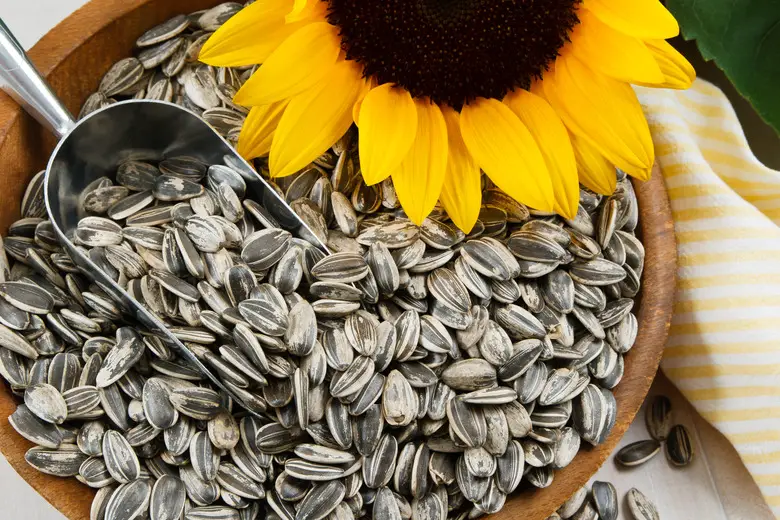Roasting sunflower seeds is a simple yet rewarding process that transforms these small, nutrient-rich kernels into a satisfying and versatile treat. Whether you enjoy them lightly salted, infused with spices, or sweetened with honey, roasted sunflower seeds are a snack that combines taste and health in every bite. They offer a satisfying crunch, a pleasant nutty flavor, and can be tailored to suit any palate.
For many, sunflower seeds are more than just a snack—they’re a healthy habit. Rich in protein, healthy fats, vitamins, and minerals, they provide long-lasting energy and support overall wellness. Learning how to roast sunflower seeds at home gives you control over flavor, salt content, and freshness. It’s an easy skill to master, requiring only a few basic tools and some attention to detail. In this guide, you’ll discover the best methods, tips, and flavoring ideas to help you create roasted sunflower seeds that are healthy, delicious, and perfectly suited to your taste.
Understanding Sunflower Seeds

Sunflower seeds come from the large, iconic flower heads of the sunflower plant. Each seed is encased in a shell, which can be either striped or solid black, depending on the variety. These seeds are available raw, roasted, salted, unsalted, or flavored, giving consumers many choices for enjoying them. When roasting at home, raw unshelled seeds offer the most flexibility for seasoning and texture control.
Sunflower seeds are a rich source of nutrients, including vitamin E, magnesium, and selenium. They also provide plant-based protein and healthy fats, making them an excellent addition to a balanced diet. Their mild, nutty taste makes them a perfect canvas for both sweet and savory flavors. By understanding the different types and characteristics of sunflower seeds, you can better decide which variety is best for your roasting preferences. Selecting high-quality seeds ensures your final product will be flavorful, crisp, and enjoyable whether eaten as a snack or incorporated into recipes.
Types of Sunflower Seeds for Roasting
Sunflower seeds for roasting generally fall into two main categories: confectionery seeds and oilseed varieties. Confectionery seeds are larger, striped, and have a thicker shell. They are the type most often sold for snacking and are ideal for home roasting because of their size and texture. Oilseed varieties, on the other hand, are smaller and have a solid black shell. These are primarily used for producing sunflower oil but can also be roasted for snacking, offering a more concentrated flavor in a smaller bite.
Choosing the right type depends on your intended use and flavor preferences. Confectionery seeds are easier to handle, crack, and season, making them perfect for beginners. Oilseed varieties, while less common for casual snacking, can be a good choice if you prefer a richer taste and don’t mind the smaller size. For the best results, select seeds that are fresh, plump, and uniform in size. This consistency ensures even roasting and a better texture in the finished snack, whether you prefer them lightly salted or boldly seasoned.
Nutritional Benefits of Sunflower Seeds
Sunflower seeds are a powerhouse of essential nutrients, offering a unique combination of healthy fats, protein, vitamins, and minerals. They are one of the richest natural sources of vitamin E, a potent antioxidant that helps protect cells from oxidative damage and supports skin health. Their magnesium content plays an important role in muscle function, bone health, and energy production, making them a smart snack for active individuals.
In addition to vitamins and minerals, sunflower seeds provide plant-based protein that supports muscle maintenance and repair. They also contain healthy unsaturated fats, which can promote heart health when consumed as part of a balanced diet. The presence of selenium in sunflower seeds contributes to immune system support and may help reduce inflammation. Roasting them at home allows you to preserve much of their nutritional value while customizing flavor and salt content to suit your needs. This combination of taste and health benefits makes sunflower seeds an excellent choice for everyday snacking.
Preparing Sunflower Seeds for Roasting
The first step in roasting sunflower seeds is ensuring you start with clean, fresh seeds. If you’ve harvested them from your own sunflowers, gently rub the seeds from the flower head and remove any remaining plant material. For store-bought raw seeds, check for any broken or shriveled seeds and discard them. Place the seeds in a large bowl of cool water and stir to loosen dirt or debris. Rinse thoroughly until the water runs clear, as clean seeds roast more evenly and develop a better flavor.
Once cleaned, the seeds can be soaked in salted water to enhance flavor and soften the shells slightly. Dissolve salt in warm water, add the seeds, and let them soak for several hours or overnight. This step allows the seasoning to penetrate the shell, giving the roasted seeds a deeper taste. For a lower-sodium option, you can skip this soak or replace salt with herbs, spices, or natural flavorings such as garlic powder, smoked paprika, or lemon zest.
After soaking, drain the seeds well and spread them out on a clean kitchen towel or baking sheet to dry. Removing excess moisture is important to prevent steaming during roasting, which could make the seeds chewy instead of crisp. Pat them gently with another towel to speed up the drying process. At this stage, you can also add any oil or seasoning mix if you want a more intense flavor. Proper preparation ensures your sunflower seeds roast evenly, achieve a crunchy texture, and maintain their natural nutty taste.
Oven Roasting Method for Sunflower Seeds
Roasting sunflower seeds in the oven is one of the most consistent and beginner-friendly methods. Begin by preheating your oven to 300°F (150°C), which is a moderate temperature that allows the seeds to toast slowly without burning. Spread your cleaned and seasoned sunflower seeds in a single layer on a baking sheet. For easy cleanup and even roasting, you can line the tray with parchment paper. Avoid overcrowding, as this can lead to uneven cooking and prevent the seeds from becoming fully crisp.
Place the tray in the oven and roast the seeds for about 30 to 40 minutes, stirring them every 10 minutes to ensure all sides toast evenly. The exact time may vary depending on seed size, moisture content, and your desired crunch level. Smaller seeds may be ready sooner, while larger ones may require a few extra minutes. Keep a close eye on them in the final stages to avoid over-roasting, as sunflower seeds can quickly go from perfectly golden to overly dark.
When the seeds are a light golden brown and emit a nutty aroma, remove them from the oven and let them cool completely on the baking sheet. This cooling period helps them crisp up fully. Taste a few to check if seasoning needs adjusting, and sprinkle on extra flavorings if desired while they are still warm. Oven-roasted sunflower seeds store well in airtight containers, retaining their crunch and flavor for weeks, making them a convenient and healthy snack to have on hand.
Temperature and Time Adjustments for Flavor
Adjusting temperature and roasting time is the key to customizing the flavor and texture of sunflower seeds. Lower temperatures, such as 250°F (120°C), allow the seeds to roast slowly, bringing out a milder, nuttier flavor while preserving more of their nutritional value. This method works well if you prefer a softer crunch and want to retain delicate seasonings like herbs or citrus zest, which may burn at higher heat.
For a bolder, deeper flavor, you can raise the oven temperature to 325–350°F (160–175°C). Higher heat creates a more intense roasted taste and a crisper texture in less time, typically between 15 to 25 minutes. However, with higher temperatures, seeds can burn quickly, especially smaller varieties, so frequent stirring and close monitoring are essential. This method is ideal for strong seasonings like chili powder, smoked paprika, or garlic salt, which develop richer notes when roasted quickly.
If you’re experimenting, try a two-stage roasting process. Start at a lower temperature to dry the seeds evenly, then finish with a short burst of higher heat for extra crunch. This approach gives you the best of both worlds: even cooking inside and a perfectly toasted shell outside. No matter which method you choose, always remember that sunflower seeds continue to cook slightly after leaving the oven, so it’s best to remove them just as they reach your preferred level of doneness. Small adjustments in time and temperature can make a big difference in the final taste and texture.
Stovetop Roasting Method for Sunflower Seeds
The stovetop roasting method is a quick and convenient way to prepare sunflower seeds without using an oven. Begin by placing a large, heavy-bottomed skillet or frying pan over medium heat. Add your cleaned and seasoned seeds directly to the dry pan, ensuring they are spread out in an even layer. A heavy-bottomed pan distributes heat evenly, reducing the risk of scorching. You can add a light drizzle of oil if you prefer a richer flavor and extra crispness, but it’s not strictly necessary.
As the seeds heat up, stir them frequently with a wooden spoon or spatula to ensure even roasting. The constant movement helps prevent hot spots that could cause some seeds to burn while others remain undercooked. Depending on the pan’s size and the seed quantity, this process usually takes between 10 to 15 minutes. You’ll notice a fragrant, nutty aroma as the seeds begin to toast, and the shells will turn a light golden color. Adjust the heat as needed to maintain steady roasting without excessive browning.
Once the seeds have reached your desired level of crunch and color, remove them from the skillet immediately to stop the cooking process. Transfer them to a plate or baking sheet to cool in a single layer. Cooling is essential because seeds left in a hot pan will continue cooking and may develop a bitter taste. The stovetop method is perfect for making small batches, testing new seasoning blends, or preparing a fresh snack in minutes without preheating an oven.
Seasoning Ideas for Healthy and Delicious Sunflower Seeds
Seasoning sunflower seeds can transform a simple snack into something bold, savory, or even sweet. For a classic flavor, lightly coat the seeds with olive oil and sprinkle them with sea salt before roasting. This enhances their natural nuttiness while adding a satisfying crunch. You can also try garlic powder, onion powder, or smoked paprika for a deeper, savory taste. These seasonings cling well to the shells and intensify during the roasting process.
For a spicier kick, combine chili powder, cayenne pepper, and a touch of lime zest. The heat from the spices pairs beautifully with the tangy brightness of citrus, creating a snack that’s both refreshing and bold. If you want a sweet twist, toss the seeds with a small amount of honey or maple syrup along with cinnamon before roasting at a slightly lower temperature to prevent burning. Sweetened sunflower seeds work well as a topping for yogurt, oatmeal, or salads.
Experimenting with international flavors can also keep your sunflower seed snacks exciting. Try coating the seeds with soy sauce and sesame oil for an Asian-inspired flavor, or use cumin, coriander, and turmeric for a warm, earthy profile. The key is balancing the seasoning with the seeds’ natural taste, so start with small amounts and adjust after roasting. Sunflower seeds readily absorb flavor, meaning a little seasoning goes a long way. With endless possibilities, you can create a new version every week and never get tired of this healthy, versatile snack.
Health Benefits of Roasted Sunflower Seeds
Roasted sunflower seeds are not only a tasty snack but also a rich source of nutrients that support overall health. They are packed with vitamin E, a powerful antioxidant that protects cells from damage and promotes healthy skin. Sunflower seeds also contain magnesium, which supports muscle function, helps regulate blood pressure, and improves bone health. Including them in your diet can provide a satisfying crunch while delivering essential nutrients your body needs daily.
These seeds are also an excellent plant-based source of healthy fats, particularly polyunsaturated and monounsaturated fats. These fats help maintain heart health by reducing bad cholesterol levels and supporting good cholesterol production. In addition, sunflower seeds offer a good amount of protein, making them a convenient option for those looking to increase their daily intake without relying solely on animal products. The combination of protein, healthy fats, and fiber helps keep you feeling full longer, making them a great choice for weight management.
Sunflower seeds also contain selenium, copper, and zinc, which boost immune function and promote wound healing. Their high antioxidant content can help reduce inflammation in the body, lowering the risk of chronic diseases. When roasted properly without excessive salt or added sugar, sunflower seeds provide a wholesome, nutrient-dense snack that can easily fit into a balanced diet. Whether enjoyed on their own, sprinkled over salads, or blended into homemade trail mixes, they are a simple way to add both flavor and nutrition to your daily routine.
Storage Tips for Freshness and Flavor
Proper storage of roasted sunflower seeds is essential to preserve their crunch, flavor, and nutritional value. Since they contain natural oils, sunflower seeds can become rancid if exposed to air, light, or heat for prolonged periods. After roasting, allow the seeds to cool completely before transferring them to an airtight container. Glass jars with tight-fitting lids or food-grade plastic containers work best for locking in freshness. Keeping the seeds in a cool, dark place will help maintain their quality for several weeks.
If you live in a warm or humid climate, consider storing roasted sunflower seeds in the refrigerator. This prevents the oils from spoiling and extends their shelf life to several months. Be sure the container is well-sealed to prevent moisture from affecting the texture. For even longer storage, you can freeze sunflower seeds in a freezer-safe bag or container. When ready to enjoy, simply let them thaw at room temperature for a few minutes without losing their crispness.
It’s also important to store seeds separately from strong-smelling foods, as they can absorb odors over time. If you’ve seasoned the seeds with herbs or spices, check them periodically for freshness, as seasonings may lose potency faster than the seeds themselves. Proper storage not only keeps your sunflower seeds tasting their best but also ensures you get the maximum nutritional benefit from every bite. With a few simple steps, you can enjoy roasted sunflower seeds that stay fresh and flavorful for months.
Common Mistakes to Avoid When Roasting Sunflower Seeds
Over-roasting the Seeds
One of the most common mistakes when roasting sunflower seeds is leaving them in the oven for too long. Even a few extra minutes can cause the seeds to burn, resulting in a bitter taste that overpowers their natural nuttiness. Always monitor the seeds closely during the final minutes of roasting, as they can go from golden to burnt quickly. It’s best to stir them occasionally to ensure even heat distribution.
Another tip is to roast at a moderate temperature rather than turning up the heat to speed up the process. Lower heat allows the seeds to cook evenly, keeping their texture crunchy without sacrificing flavor. Patience will yield a better-tasting, more enjoyable snack.
Using Too Much Salt or Seasoning
While seasoning enhances flavor, using too much salt or spice can overwhelm the natural taste of sunflower seeds. Over-salting not only affects the flavor but also makes the snack less healthy, especially for those watching their sodium intake. Start with a small amount and taste-test before adding more.
Additionally, applying too much oil or sticky sweeteners can make seeds clump together, leading to uneven roasting. Lightly coating the seeds ensures seasonings stick without creating soggy spots. Balanced seasoning will help highlight, rather than hide, the seeds’ delicious nutty profile.
Creative Ways to Enjoy Roasted Sunflower Seeds
Adding to Everyday Meals
Roasted sunflower seeds are a versatile topping that can enhance both flavor and texture in everyday dishes. Sprinkling them over salads adds a delightful crunch and boosts the nutritional profile of your greens. They also work wonderfully in grain bowls, pasta dishes, and soups, where they add a subtle nutty note. You can even mix them into scrambled eggs or omelets for a savory twist.
Another way to incorporate them into meals is by blending them into sauces or dips. Ground sunflower seeds can give a creamy texture to pesto or hummus without the need for dairy. This makes them a great choice for vegan or lactose-free diets while still providing a rich flavor.
Using in Snacks and Baking
Sunflower seeds are perfect for snacking on their own, but they also pair well with other ingredients to create wholesome treats. Combine them with dried fruits, nuts, and dark chocolate chunks for a nutrient-dense trail mix. They’re also a great addition to granola bars, providing crunch and healthy fats.
In baking, roasted sunflower seeds can be stirred into bread dough, muffins, or cookies for an earthy flavor and added texture. For a sweet-savory combination, sprinkle them over banana bread or coffee cake before baking. These creative uses make sunflower seeds a pantry staple that’s both tasty and nutritious.
FAQ About How to Roast Sunflower Seeds
How do I know when sunflower seeds are done roasting?
Sunflower seeds are ready when they turn golden brown and release a warm, nutty aroma. The roasting time can vary depending on your oven and seed size, usually between 10 and 20 minutes at 300–350°F. Stir the seeds halfway through for even cooking. Taste one after cooling for a minute — they should be crunchy but not overly hard or burnt.
Can I roast sunflower seeds without oil?
Yes, you can roast sunflower seeds dry, and they will still develop a crisp texture and rich flavor. Spread them evenly on a baking sheet to allow heat to circulate. Dry roasting works well for those wanting a lower-calorie or oil-free snack. However, a light coating of oil helps seasonings stick better and can enhance the seeds’ natural flavor.
How long do roasted sunflower seeds last?
When stored properly in an airtight container in a cool, dry place, roasted sunflower seeds can last up to three weeks at room temperature. For longer storage, refrigerate them for up to three months or freeze them for six months. Always allow them to cool completely before sealing to prevent condensation, which can lead to sogginess or mold.
Are roasted sunflower seeds still healthy?
Yes, roasted sunflower seeds retain most of their nutrients, including healthy fats, protein, and essential minerals like magnesium and vitamin E. However, roasting at very high temperatures for too long may reduce some antioxidants. Choosing moderate heat and avoiding excess salt or added sugar keeps them a nutritious snack option.
Can I roast sunflower seeds in a pan instead of an oven?
Absolutely. Place the seeds in a dry skillet over medium heat and stir frequently to avoid burning. Pan roasting usually takes 5 to 10 minutes, depending on seed size. Keep a close eye on them, as they can scorch quickly. Once they’re golden and aromatic, remove from heat and let cool before eating.
Conclusion
Roasting sunflower seeds at home is simple, rewarding, and offers endless flavor possibilities. By choosing quality seeds, roasting at the right temperature, and experimenting with seasonings, you can create a snack that’s both healthy and delicious. Whether enjoyed on their own, sprinkled over meals, or used in baking, roasted sunflower seeds bring crunch and nutrition to your diet. With the tips in this guide, you’ll master the process and enjoy fresh, flavorful seeds anytime you crave them.






